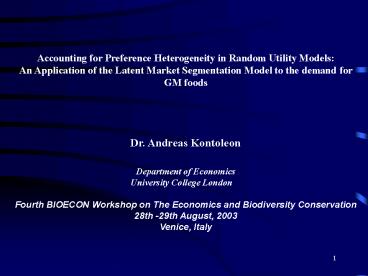Accounting for Preference Heterogeneity in Random Utility Models: PowerPoint PPT Presentation
1 / 18
Title: Accounting for Preference Heterogeneity in Random Utility Models:
1
Accounting for Preference Heterogeneity in
Random Utility Models An Application of the
Latent Market Segmentation Model to the demand
for GM foods Dr. Andreas Kontoleon Department
of Economics University College London Fourth
BIOECON Workshop on The Economics and
Biodiversity Conservation 28th -29th August,
2003 Venice, Italy
2
The GM food debate
PERCEIVED BENEFITS
PERCEIVED RISKS
- Food safety and health concerns
- For example
- new allergies.
- resistance to antibiotics.
- new viruses and mutations.
- Environmental concerns
- For example
- super-weeds
- reduce the levels of genetic diversity
- Ethical and religious concerns
- Food quality concerns
- For example
- Spoil food taste
- Food uniformity
- Improved nutritional content
- Improved taste and variety
- Increased yield/output
- Reduced pesticide use
- Reduced water use
- Cheaper food for consumers
- Benefits to the environment
- Benefits to LDCs
3
Common recommendation
Labelling
- May resolve trade disputes
- Retains consumer sovereignty
Yet, it is a complex issue
- What is the cost of labelling?
- Is there a viable market for GM-free products?
- What is the threshold for GM certification?
4
Hence, it is highly policy relevant to assess -
Distributional impacts - Size and nature of
niche markets
Need to assess preference heterogeneity in the
demand for GM foods
- Case study
- Stated preference Vs. revealed preference
demand analysis - Contingent valuation Vs. Choice Experiment
modelling - Single food product Vs. set of food products
- Which food product? ? Eggs
5
Choice Set Design
6
Elements of choice experiment/conjoint analysis
- Select attributes and levels
- Design choice sets
- Collect multiple responses form each individual
- Analyse data using multinomial choice model
- Econometric model framed as a Random Utility
Model
7
Random Utility Model
Estimated ? parameters used to calculate welfare
measure, market shares, predicted probabilities
etc.
8
Accounting for preference heterogeneity in RUM
- Problematic since individual characteristics do
not vary across choices.
- Various approaches to overcome this obstacle
- Interaction effects models
- Random parameter logit models
- Latent class models
Latent Segmentation Model Simultaneously
accounts for choice and segment membership.
9
A Structural model of latent segmentation and
choice (adapted from McFadden, 1986)
Attitudinal perceptual and motivational
indicators
Socio-demographic characteristics
Objective product attributes
Attitudes, perceptions and motives
Perceptions of product attributes
Membership likelihood
Latent Class selection
Latent Class
Preferences
Decision Tool
Institutional setting and constraints
Choice Behaviour
10
Mixed-logit model
Segment membership function
Multinomial choice function
11
Estimation Strategy
- Use factor analysis to estimate attitudinal
proxies - Parameterise the full mixture model (i.e. the
vectors X, Z above) - Run the full model for various segments (1, 2, 3,
4 ) - Stop when estimation ceases improving the LogL
- Use a combination of criteria based on the AIC
statistic to choose the model with optimal number
of segments
12
Perceptual and attitudinal latent variables
Factor 1 Ethical resistance Factor 2 Mistrust
and disbelief Factor 3 Environment concerns
Factor 4 Cost and bargain concerns Factor 5
Food safety concerns
13
Choosing optimal number of segments
14
Results from three segment model
15
Interpretation of Segments
Segment 1 food optimists (53.5) Segment 2 food
cautious (38.8) Segment 3 ethical opponents
(7.7)
16
Implicit ranking of attributes across segments
17
Concluding remarks
GM debate on labelling can benefit from such
quantitative studies that Explore preference
heterogeneity at the segment level. Assess the
nature and extent of latent segments. Simultaneous
ly accounts for choice and segment
membership. Utilise an interdisciplinary approach
that incorporates Economic information
(observable choices). Demographics information
(observable individual characteristics) Psychomet
ric information (latent individual
characteristics)
18
Accounting for Preference Heterogeneity in
Random Utility Models An Application of the
Latent Market Segmentation Model to the demand
for GM foods Dr. Andreas Kontoleon Department
of Economics University College London Fourth
BIOECON Workshop on The Economics and
Biodiversity Conservation 28th -29th August,
2003 Venice, Italy

